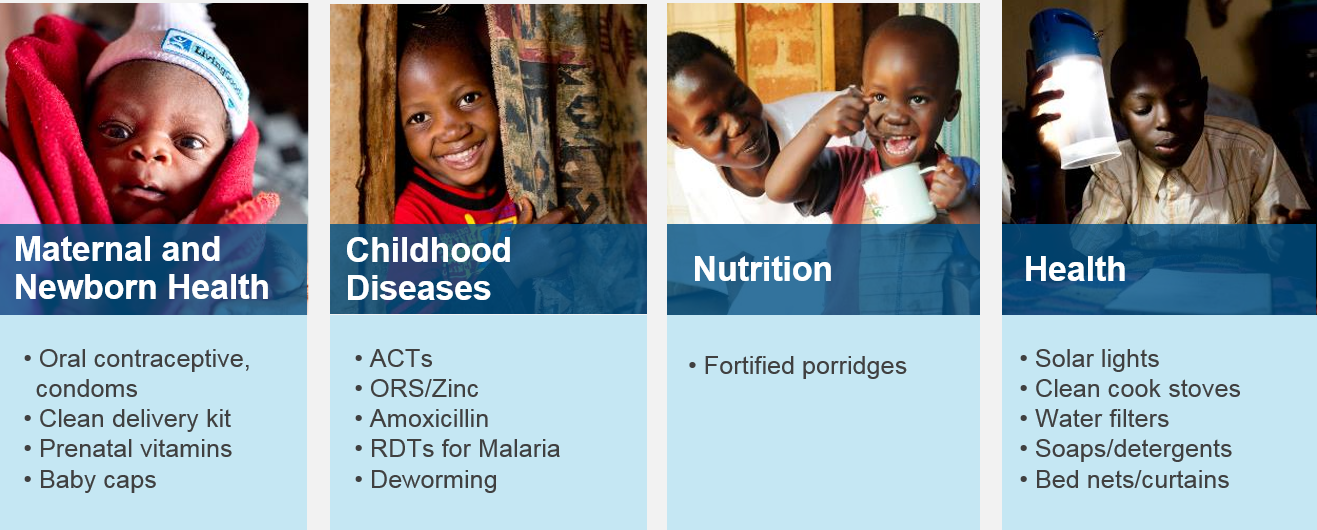The GSMA mHealth team hosted its bi-annual working group in January, bringing together our partners across eight countries in Sub-Saharan Africa under one roof in Uganda. The objective was to share learnings amongst all partners each bringing their own experiences from their particular markets. As part of the working group, we had the opportunity to have a field visit with our Ugandan partner Living Goods .
Living Goods harnesses the power of micro-entrepreneurs to redefine rural trade and promote healthy behaviours during pregnancy and infant child growth. By adopting an ‘Avon style model’ the service rigorously trains women to become ‘Community Health Promoters’ (CHP’s) who then operate as independent agents travelling door to door to offer affordable and effective solutions designed to improve quality of life. A five year ‘Randomized Control Trial‘ has shown that this programme has led to a 27% reduction in under-five mortality and up to 72% increase in likelihood of home visits in the first seven days of post-natal period.
The model is designed to address key shortcomings faced by both end users and health care workers. For end users there is a high cost burden involved in attaining medicines and key products needed for a healthy pregnancy. Even though health systems offer certain medicines for free, users are still faced with transport costs not forgetting the cost of time spent travelling waiting. Once at the clinic, surveys have shown that there is only a 50% probability of medicines being in stock. As such Living Goods have pegged their average price per treatment at 50 cents (USD) making this a much more affordable proposition for end users.
Sub-Saharan Africa has 25% global disease burden but only 3% of health workers posing a high resource burden. Effective and well trained health workers can create cost savings in areas of the health system including reduction in the patients treated at facilities creating more cost efficiencies. To combat this shortage Living Goods aims to retain community health presence through: provision of incentives and motivation to visit households, adherence to standards of quality and performance management and ensuring a well-run stock supply chain. CHP’s play a vital role in the health value chain by enabling the following:
- Higher level of data collection: Equipped with a smartphone from Living Goods, a CHP can carry out multiple functions including registration and updating health records of women and children electronically which is stored on LG’s database and feeds in directly to the country’s health database.
- Educate parents on healthy behaviours: For families who cannot visit health facilities due to distance, a CHP can be one of the only channels of validated health content. Upon registration of pregnancy a mother will receive SMS content tailored to the stage of the pregnancy or age of the infant providing further information on a range of topics such as nutrition and vaccination reminders.
- A market place for products supporting a healthier lifestyle: CHP’s will always bring a host of health products supplied (and few manufactured) by Living Goods. These range from deworming tablets to cook stoves. These products not readily available on the market are sold at a competitive rate where the CHP’s earns a small commission on every product sold.
How do the mobile tools work?
During the field visit we had the pleasure of visiting distribution centres located outside Kampala for a chance to interact with branch staff, CHP’s and end users. We also had the opportunity to gain insight on Living Goods ‘smart mobile tools’ that effectively utilise different mobile use cases to complement efforts by branch staff and agents. Living Goods operate on a customisable platform managed by Medic Mobile. The platform has a simple user interface and is deployed to accomplish four key metrics:
1. Improve CHP Performance in the Field
- The Android application is used to register pregnancies, conducting Integrated Community Case Management (ICCM) assessments and flagging high risk cases for referral.
- A uniformed platform ensures that all CHP’s are following the Ministry of Health approved protocols and are providing the same recommendations to all clients.
- Creation of automated daily tasks for CHP’s (e.g. reminder to follow up with high risk patients).
2. Improve Performance Management
- The dashboard allows to track key metrics, pregnancies and follow ups. CHP’s are given quotas to remain in the programme and this dashboard allows real time performance review.
- Dashboard is customized to suit different roles within the organisation from field supervisors to field managers.
3. Improves Patient Compliance & Healthy Behavior
- Users receive personalized nutrition and health SMS messages throughout pregnancy along with their CHP contact information. User research has shown that this has led to increased contact from parents who now have trusted source of information.
- Reminder SMSs are sent to users on nutrition and ANC visits.
- The service will also send information to caregivers to ensure higher levels of compliance to healthy behaviours.
4. Improved Supply Management System
- The platform tracks movement of goods ensuring all branches are properly stocked
- Data analytics to monitor performance of goods allowing for more effective product portfolio management
What’s next for Living Goods?
Living Goods plans to scale nationally in Uganda. The programme will be increasing their efforts to recruit and train CHP’s and branch staff to accommodate for the growing number of branches.
At the end of the field visit, it was evident how community centred/focused healthcare has potential to reach populations with limited resources, and also provide first line of support in avoiding preventable diseases like malaria, diarrhoea, and malnutrition.


